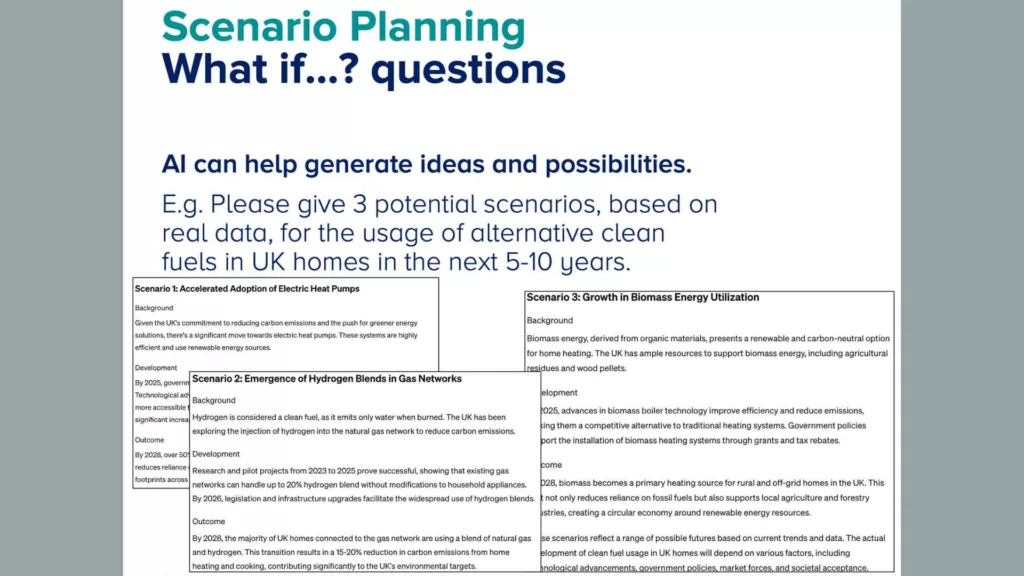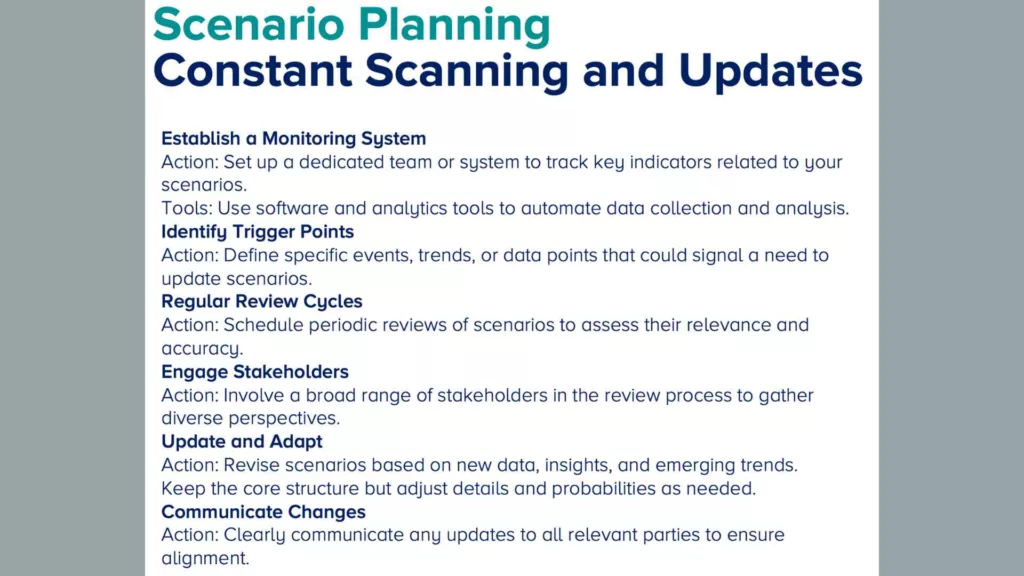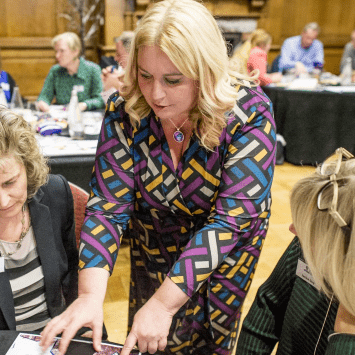Posted in Blog, Innovation, Sustainability by Jo North
Introduction to Scenario Planning and Sustainable Innovation
Scenario planning is a useful for achieving successful sustainable innovation.The world is in a period of significant transition due to climate change and the technology revolution. The pace of change is relentless and the future is uncertain, making strategic planning for sustainable innovation really challenging. By using scenario planning to explore a range of possible futures, organizations can uncover less obvious insights and facts that prepare them for what may lie ahead, drive sustainable practices and make sure the business model stays relevant.
This article provides a guide to using scenario planning to support successful sustainable innovation.
My Experience with Scenario Planning for Sustainable Innovation
The scenario planning process and tools that I’m sharing here are those that I have found really helpful in my own experience of facilitating sustainable innovation sprints and workshops, as well as in delivering hands-on sustainable innovation consulting projects for my clients.
For example:
- Working with South East Water to co-create a 25 year environment strategy with a large and diverse group of key stakeholders.
- Supporting Northumbrian Water with their organizational readiness to spearhead a transformative agenda in the UK water sector, focusing on increased efficiency and elevated service levels. Northumbrian Water has pledged an even stronger commitment to addressing climate change and enhancing customer service, societal impact, and environmental stewardship.
- Facilitating the Port of Tyne‘s sustainable maritime strategy for the next 25 years, Tyne2050.
Understanding Sustainability
Sustainability integrates environmental, social, and economic considerations. It’s about balancing these dimensions to foster a world where businesses thrive without harming our planet or society. This approach is vital for long-term success and resilience, emphasizing the importance of making decisions today that don’t compromise tomorrow.
What Is Sustainable Innovation?
Sustainable innovation centers on creating new solutions that ensure a prosperous economy while protecting our environment and society. It’s innovation with a conscience, focusing on projects and business models that support the well-being of future generations.
The Role of Scenario Planning
Scenario planning is a strategic tool that helps mitigate risks, spot opportunities, and explore the potential of sustainable innovation projects. It pushes organizations to think beyond immediate gains, encouraging strategies that guarantee long-term viability and address complex challenges, such as climate change and social inequality.

What is Scenario Planning?
Scenario planning is a technique used to mitigate risk, identify opportunities, and think through possibilities for your sustainable innovation projects. It involves asking “what if…?” questions about potential futures, so that your organization can plan and prepare for those that are the most likely and might have the greatest impact.
“By forcing organizations to consider a variety of long-term futures, scenario planning encourages a shift away from short-term gains in favor of strategies that ensure long-term sustainability and success. This long-term perspective is crucial for addressing systemic challenges such as climate change, resource depletion, and social inequality.”
Ramirez & Wilkinson, Strategic Reframing, The Oxford Scenario Planning Approach
Scenarios navigate between facts and perceptions. They seek out facts but target the perceptions of those making decisions. The goal is to collect strategically important information and convert it into new insights. This conversion is challenging, but when successful, helps organizations to identify strategic priorities for sustainable innovation.


Example of Scenario Planning in Practice: Shell
Shell, the global energy giant, has long been renowned for its approach to strategic planning. Central to its strategy is the use of scenario planning, a method that has allowed Shell to navigate through volatile markets and uncertain futures.
Scenario planning at Shell dates back to the early 1970s. The company found itself in a rapidly changing energy market, with oil shocks and geopolitical tensions reshaping the landscape. Pierre Wack, a planner at Shell, pioneered the approach of scenario planning to anticipate and prepare for various future possibilities. Unlike traditional forecasting, which often relies on a single predictive model, scenario planning involves creating several detailed narratives about possible futures, each based on different assumptions and variables.
Shell Today
Shell continues to use scenario planning today to explore how the future could unfold to help make better decisions. By offering different possible versions of the future, Shells says that their work “stretches minds, confronts assumptions and helps people think differently about the world around them.”
They go on to say: “Our scenarios are not predictions about the future, do not involve a crystal ball and are not Shell strategy. Even so, the leadership teams in Shell have been using this work to help make decisions for more than 50 years.”
Shell’s scenarios team has created two significant long-term projections for the global energy system. These models are essential for evaluating, measuring, and investigating various possibilities for future scenarios. Combined, they provide insight into the present state of the world’s energy scenario and enable the simulation of multiple potential futures.
Whilst scenario planning is often associated with Shell, it can be applied to any industry and help organizations prepare for any potential future scenarios.

Types of Scenario Planning
Quantitative Scenarios
This approach uses financial models to predict best and worst-case outcomes, aiding in strategic financial planning, business cases and risk management.
Operational Scenarios
These scenarios help businesses prepare for and respond to sudden challenges, enhancing operational continuity and resilience.
Normative Scenarios
Focused on achieving a desired future, normative scenarios guide long-term goals and strategic alignment.
Strategic Management Scenarios
By examining the impact of external forces, these scenarios assist in strategic planning and adaptation to industry and economic trends.
Sustainable Innovation Scenarios
Centered on ESG principles, this approach aims at long-term sustainability, promoting practices beneficial to the company, society, and the environment.
Supporting Sustainable Innovation Through Scenario Planning
Opportunity Identification
Scenario planning uncovers opportunities for sustainable products and business models by examining various futures, like increased climate change awareness leading to a demand for renewable energy solutions.
Breakthrough Innovations
Collaboration across disciplines can spark innovative solutions that align with sustainability goals, such as advancements in green technology or sustainable urban development.
Long-Term Perspective
By considering different long-term futures, businesses can shift focus from short-term gains to strategies that ensure lasting sustainability and success.

10-Step Scenario Planning Process
- Begin with Your Organization’s Core: Align with your purpose, mission, vision, and values.
- Horizon Scanning: Assess external factors and possible outcomes.
- Engage Stakeholders: Involve key players in the planning process.
- Develop and Combine Scenarios: Create diverse scenarios to cover various possibilities.
- Utilize Scenario Planning Models and Tools: Enhance decision-making with methods like matrix-based planning, driver analysis, and quantitative modeling.
- Evaluate Impact and Likelihood: Analyze scenarios for potential impact and probability.
- Identify Opportunities and Risks: Pinpoint strategic opportunities and potential pitfalls.
- Create an Action Plan: Prepare for key scenarios with strategic responses.
- Monitor Indicators: Stay alert to signs that may trigger scenario activation.
- Iterate: Update and refine scenarios regularly to reflect new insights and conditions.
Enhancing Decision-Making with Scenario Planning Models
Incorporating models and tools such as matrix-based planning, driver analysis, cross-impact analysis, and quantitative modeling enriches the scenario planning process. These approaches provide a structured way to explore potential futures and prepare strategic responses, ensuring organizations are ready to navigate uncertainties with confidence.
Implementing Matrix-Based Planning
Step 1: Identify Key Variables
Start by pinpointing two critical uncertainties that could significantly impact your business. These uncertainties should be independent of each other and represent different dimensions of the future landscape.
Step 2: Construct a Matrix
Create a 2×2 matrix with these variables on each axis, representing extreme values (high/low or positive/negative) of these uncertainties. This will give you four quadrants, each depicting a distinct scenario.
Step 3: Develop Scenarios
For each quadrant, develop a detailed narrative that describes how the world looks under those conditions. Consider how these scenarios affect your business and what strategies would be effective in each.


Conducting Driver Analysis
Step 1: List Key Drivers
Identify and list down the key drivers that could influence the future of your industry. These drivers could be technological advancements, regulatory changes, economic trends, etc.
Step 2: Assess Impact and Uncertainty
Evaluate each driver based on its potential impact on your business and the level of uncertainty it represents. Focus on drivers with high impact and high uncertainty for deeper analysis.
Step 3: Prioritize Drivers
Select the most critical drivers to construct your scenario planning. These should be the forces that are most likely to shape the future landscape of your business.

Applying Cross-Impact Analysis
Step 1: Identify Factors and Scenarios
List the factors (economic, social, technological, etc.) that could influence your scenarios. Develop initial scenarios based on these factors.
Step 2: Analyze Interactions
Evaluate how each factor might influence the others. This step helps in understanding the complex interdependencies and how they might combine to create different futures.
Step 3: Refine Scenarios
Use the insights from the interaction analysis to refine your scenarios, making them more robust and interconnected. This helps in creating a more comprehensive view of potential futures.
Utilizing Quantitative Modeling
Step 1: Select Variables
Choose variables that are crucial for your business and can be quantitatively measured. These could include sales volumes, market growth rates, cost inputs, etc.
Step 2: Develop Models
Create mathematical models that simulate the relationships between these variables. This might involve statistical methods, regression analysis, or other mathematical techniques.
Step 3: Run Simulations
Use these models to simulate different scenarios, adjusting the variables based on the different futures you’ve envisioned. This will help you understand potential outcomes and quantify risks and opportunities.
Step 4: Analyze Results
Examine the output from your simulations to identify patterns, risks, and opportunities. Use these insights to inform strategic decision-making and scenario planning.
Bringing It All Together
Incorporating these models and tools into your scenario planning process can significantly enhance your strategic insights and decision-making. By understanding and applying matrix-based planning, driver analysis, cross-impact analysis, and quantitative modeling, you’re better equipped to navigate future uncertainties. Remember, the goal is not to predict the future accurately but to be prepared for various possible futures, ensuring your business remains resilient and agile.
Continuous Monitoring and Updates
Scenario planning is not a one-off exercise but an ongoing practice that keeps your business aligned with its long-term vision while navigating the complexities of sustainability and innovation. The key steps you will need to take are:
1. Establish a Monitoring System
Action: Set up a dedicated team or system to track key indicators related to your scenarios.
Tools: Use software and analytics tools to automate data collection and analysis.
2. Identify Trigger Points
Action: Define specific events, trends, or data points that could signal a need to update scenarios.
3. Regular Review Cycles
Action: Schedule periodic reviews of scenarios to assess their relevance and accuracy.
4. Engage Stakeholders
Action: Involve a broad range of stakeholders in the review process to gather diverse perspectives.
5. Update and Adapt
Action: Revise scenarios based on new data, insights, and emerging trends.
Keep the core structure but adjust details and probabilities as needed.
6. Communicate Changes
Action: Clearly communicate any updates to all relevant parties to ensure alignment.

Scenario Planning – Summary
Scenario analysis or planning is a critical tool for businesses to prepare for a range of future possibilities, from best to worst-case scenarios. It involves creating a set of plausible futures and developing contingency plans to manage potential risks effectively. This approach helps businesses navigate the uncertain business environment by considering various factors, including economic conditions, technological forces, and supply chain challenges.
The process of scenario planning allows companies to explore different ways their future could unfold. It’s a structured process that requires input from all levels of an organization, from finance teams implementing best practices to leadership teams making key strategic decisions. This collaborative effort ensures that a business is prepared for any given scenario, enhancing its strategic foresight and incorporating it into the strategic planning process.
Scenario Planning Benefits All Organizations
Scenario planning projects are not just for large corporations like Royal Dutch Shell but also benefit nonprofit organizations, providing them with a framework to anticipate changes in their operating environment over the long term. By considering a series of plausible scenarios, businesses can identify early indicators of potential changes, enabling them to adjust their strategies accordingly.
Common types of scenario planning include preparing for natural disasters, economic downturns, and shifts in market demand. These scenarios help businesses understand the importance of scenario planning in maintaining long-term success. The iterative process of scenario planning involves regularly updating and refining scenarios based on new data and emerging trends, ensuring that the business remains agile and responsive to changes.
Effective scenario planning requires the use of software tools, sensitivity analysis, and a team aligned around the strategic vision of the organization. It’s about making informed decisions that steer the company towards its preferred scenario, optimizing resource allocation and ensuring team alignment.
In essence, scenario planning is a vital component of a business’ strategic planning toolkit, offering a methodical approach to navigate the future’s uncertainties. It empowers businesses to make informed decisions, prepare for potential challenges, and seize opportunities for future success.
Next Steps
If you’d like our help to run an in-person or online facilitated scenario planning workshop for your team, I’d love to hear from you. Please get in touch here to book in a complimentary discovery call.


